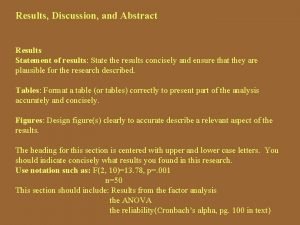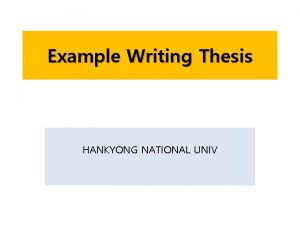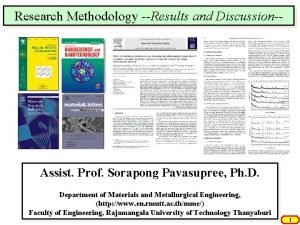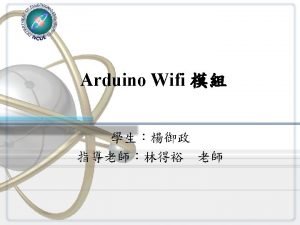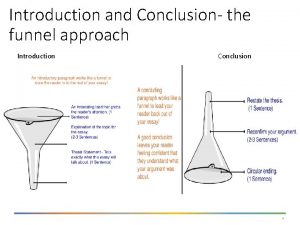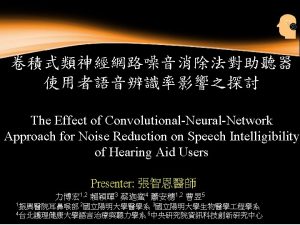2 Outline Introduction Method Results and Discussion Conclusion


















- Slides: 18


2 -Outline- Introduction Method Results and Discussion Conclusion

Introduction Method Results and Discussion Conclusion Water deficient problem 1. Typhoon, Matsa(馬莎颱風) (2005/08/05) 2. The water company solved the water deficient problem by pumping groundwater near the Taoyuan canal. 3. Linsley and Franzini(1979), the groundwater is usually cleared of sediments if flowing through fine-grained materials within a distance of 30 m. 3

Introduction Method Results and Discussion Water deficient problem Pumping groundwater near a stream Stream Depletion Rate (SDR) Large drawdown 1. Vertical well (e. g. , Hunt, 1999; Zlotnik and Huang, 1999; Bulter et al. , 2001; Fox et al. , 2002; Chen and Yin, 2004; Sun and Zhan, 2007; Bulter et al. , 2007; Yeh et al. , 2008; Zlotnik and Tartakovsky, 2008) 2. Streambed Conclusion 4

Introduction Method Results and Discussion Conclusion Water deficient problem Pumping groundwater near a stream Stream Depletion Rate (SDR) Large drawdown Horizontal well 1. Some locations such as buildings, roads, etc. 2. Thin aquifer 3. Better contact within the stratum 4. Operating costs reduction (Joshi, 2003) 5

Introduction Method Results and Discussion Conclusion Water deficient problem Pumping groundwater near a stream Stream Depletion Rate (SDR) Large drawdown Horizontal well 1. Zhan et al. (2001) provided an analytical solution to describe flow toward a horizontal well in an anisotropic confined aquifer. 2. Zhan and Zlotnik (2002) extended point source solution to the cases of slanted wells based on the principle of superposition. 3. Sun and Zhan (2006) mentioned the use of a horizontal well in an aquitard-aquifer system beneath a water reservoir for water supply. 6

Introduction Method Conceptual Model Results and Discussion Conclusion 7

Introduction Boundary & Initial Conditions datum Method Results and Discussion Conclusion 8

Introduction Method Results and Discussion Conclusion 9 Mathematic Fourier sine transform B. C. Fourier transform Finite Fourier cosine transform I. C. First-order ordinary differential equation

Introduction Method Results and Discussion Conclusion The head solution • Applying inverse Fourier transforms and the principle of superposition point source solution 10

Introduction Method SDR • Applying Darcy’s Law Results and Discussion Conclusion 11

Introduction Method Effects of well distance on SDR Results and Discussion Conclusion 12

Introduction Method Results and Discussion Effects of well direction and length on SDR Conclusion 13

Introduction Method Results and Discussion Conclusion Best α and β for less time for reaching quasi-steady state β = 90°, vertical well α = 90°, well parallel to the stream 14

Introduction Method Effect of anisotropic aquifer Results and Discussion Conclusion 15

Introduction Method Results and Discussion Conclusion 16 Drawdown of horizontal and vertical wells 1. various depth of the horizontal well 2. various length of the horizontal well

Introduction Method Results and Discussion Conclusion 1. The SDR is almost independent of the length of the horizontal well. The SDR reaches quasi-steady state more quickly if the well is closer to the stream. 2. To avoid producing large drawdown and have less time for reaching quasi-steady SDR, the horizontal well would be better to install parallel to the stream. 3. The Kx plays the key role in effecting the time for reaching quasi-steady SDR while Ky has no influence on the time for reaching quasi-steady SDR. 4. The use of a long horizontal well in producing small drawdown is better than that of a deep one under a constant pumping rate. 17

18 END Thanks for your attention!
 Introduction method result and discussion
Introduction method result and discussion Results and discussion vs conclusion
Results and discussion vs conclusion Results and discussion in research
Results and discussion in research Qualitative results and discussion
Qualitative results and discussion Example of results and discussion
Example of results and discussion It should relate directly to the aims of the report
It should relate directly to the aims of the report Methodology results and discussion
Methodology results and discussion Writing results and discussion
Writing results and discussion Result and discussion example
Result and discussion example Minuhud
Minuhud Results and discussion in research example
Results and discussion in research example Conclusion of fractional distillation
Conclusion of fractional distillation Examples of quote sandwiches
Examples of quote sandwiches Outline conclusion
Outline conclusion Quantitative data definition biology
Quantitative data definition biology Outline data
Outline data Conclusion
Conclusion Discussion vs conclusion
Discussion vs conclusion Panel discussion definition
Panel discussion definition


